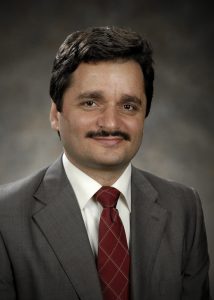A $91,000 award from the Department of Defense to buy state-of-the-art equipment for the study of atom-thin sheets of carbon for materials that could be used in electronics and aircraft has been won by a Wright State University engineering researcher.
Amir Farajian, associate professor of mechanical and materials engineering, was awarded the funding from the Defense University Research Instrumentation Program (DURIP). The award was administered through a merit competition jointly conducted by the Army Research Office, Office of Naval Research and Air Force Office of Scientific Research
The award funds equipment for Farajian’s research project titled “A Combined Experiment-Multiscale Simulation Study of 2D Nanomaterials Liquid-phase Exfoliation.”
The focus of Farajian’s research is computational nanoscience and nanotechnology, which is the study and application of extremely tiny systems. For example, two-dimensional (2D) nanomaterials, such as graphene have thickness of just one atom, which gives them unique properties that can be used in scientific fields such as chemistry, biology, physics, engineering and materials science.
“The main thing is to do very accurate computer simulations to understand basic properties and possibilities that are available by manipulating materials at the nanoscale,” said Farajian. “We also do research on nano-materials fabrication and processing from the structural point of view — how these materials can be produced and manipulated so they have the desired properties.”
The research has applications in nano- and molecular electronics, solar cell materials and transport and thermal properties important in aerospace. Possible applications include incorporating materials into the matrix of composites that are used to build aircraft or aircraft parts to improve mechanical strength or the ability to resist high temperatures.
“These are not trivial applications,” said Farajian. “We are interested in fabrication, processing and characterization to see whether we can produce these materials and have them perform at expected levels.”
The Department of Defense issued $53 million in instrumentation awards to 175 university researchers doing cutting-edge research important to national defense at 91 institutions in 36 states. The annual awards process is highly competitive. The Department of Defense received 671 proposals, requesting $254 million in funding, of which the most meritorious proposals were selected.
“DURIP instrumentation awards provide the unique means through which DOD supports universities in the acquisition of essential laboratory equipment, usually out of reach for most research grants,” said Dale Ormond, principal director for research. “DURIP is a true enabler of discovery for DOD-supported science and technology research and supports the training of the next generation science, technology, engineering and mathematics workforce.”
Farajian, his co-principal investigator Olga Pupysheva and a team of student researchers will work with graphene, which consists of a single layer of carbon atoms arranged in a hexagonal lattice.
The equipment will enable the researchers to characterize materials in an extremely accurate way. There are three different sets of equipment. The first was scheduled to arrive Oct. 20.
“We did not have these capabilities in our college, so this will provide possibilities that didn’t exist before,” said Farajian. “Without an award like this, the equipment would be impossible for us to purchase.”
Farajian earned his bachelor’s and master’s degrees in his native Iran and his Ph.D. in materials science from Tohoku University in Japan. He worked as a research scientist at Rice University in Texas before joining the faculty at Wright State in 2007.
Farajian has taught materials and mechanical engineering courses at the Wright State College of Engineering and Computer Science. He is teaching graduate courses in hydrogen energy and advanced physical properties.


 Wright State University Foundation awards 11 Students First Fund projects
Wright State University Foundation awards 11 Students First Fund projects  Gov. DeWine reappoints Board Treasurer Beth Ferris and names student Ella Vaught to Wright State Board of Trustees
Gov. DeWine reappoints Board Treasurer Beth Ferris and names student Ella Vaught to Wright State Board of Trustees  Joe Gruenberg’s 40-Year support for Wright State celebrated with Honorary Alumnus Award
Joe Gruenberg’s 40-Year support for Wright State celebrated with Honorary Alumnus Award  Wright State’s elementary education program earns A+ rating for math teacher training
Wright State’s elementary education program earns A+ rating for math teacher training  Wright State’s Calamityville hosts its largest joint medical training operation
Wright State’s Calamityville hosts its largest joint medical training operation 